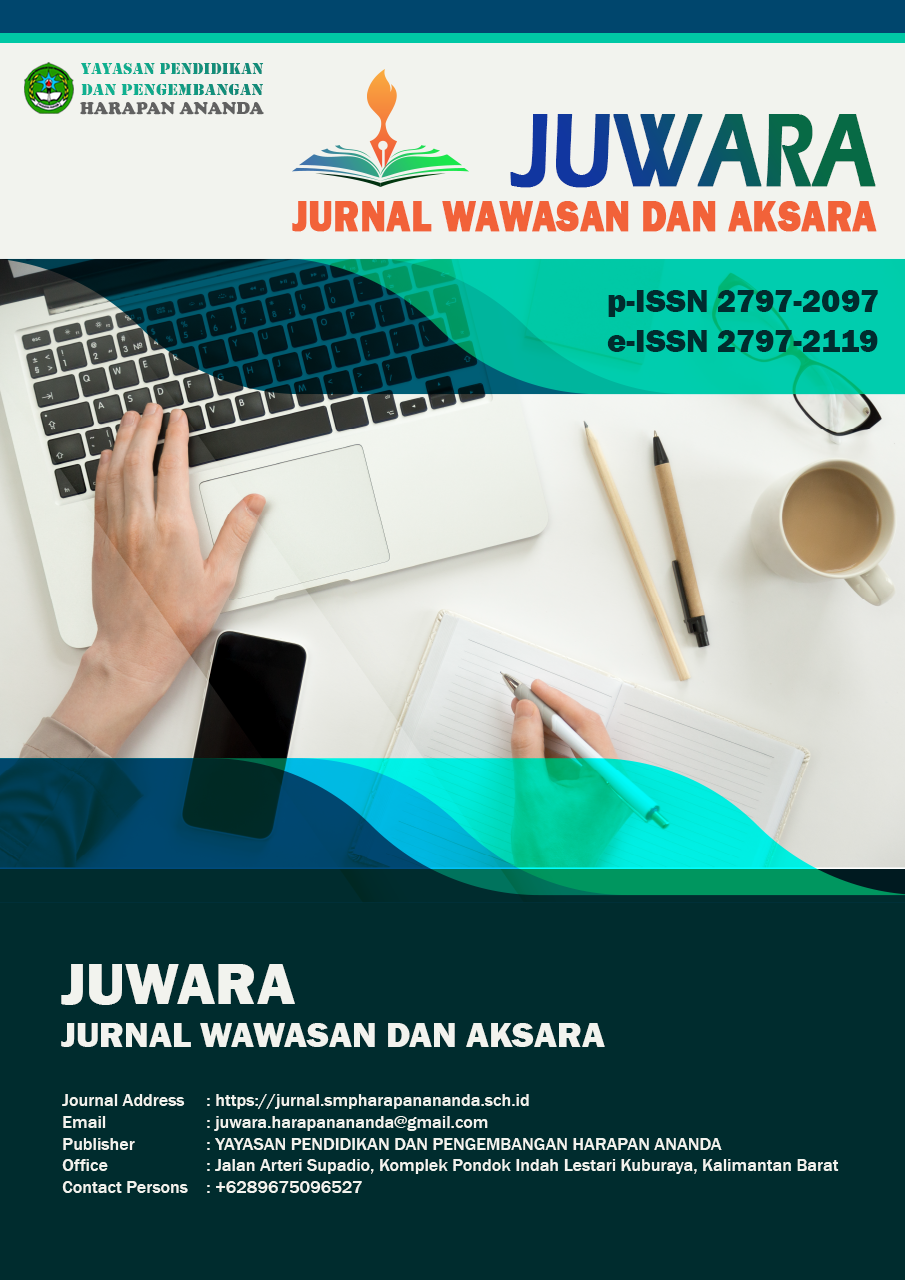Pemanfaatan Quipper School Sebagai Media Pendukung Belajar Siswa SMA Negeri 2 Sungai Raya
DOI:
https://doi.org/10.58740/juwara.v2i2.52Keywords:
Quipper School, E-LearningAbstract
AbstrakQuipper School merupakan salah satu platform pembelajaran online atau e- learning yang bersifat open source yang dapat diakses oleh siapa saja termasuk guru dan siswa, yang bertujuan untuk merevolusi cara belajar dan berbagi pengetahuan dengan memanfaatkan internet mobile. Quipper School terdiri dari dua bagian yaitu Q- Link yang diperuntukkan bagi guru dan Q-Learn yang diperuntukkan bagi siswa. Penelitian ini dilakukan dengan tujuan untuk menggambarkan tentang pemanfaatan e-learning Quipper School yang digunakan oleh siswa SMA Negeri 2 Sungai Raya sebagai sarana pendukung kegiatan belajar. Dalam penelitian ini menggunakan teori model Unified Theory of Acceptance and Use of Technology (UTAUT) dari Venkatesh et. al (2003) yang digunakan untuk mengukur penerimaan dan penggunaan sistem informasi baru. Metode yang digunakan dalam penelitian ini adalah kuantitatif deskriptif dengan teknik pengambilan sampel yakni purposive sampling. Hasil analisis yang diperoleh memperlihatkan bahwa sebagian besar siswa SMA Negeri 2 Sungai Raya telah menerima dan memanfaatkan Quipper School dengan baik di sekolah. Berdasarkan hasil analisis penelitian diketahui bahwa siswa SMA Negeri 2 Sungai Raya memiliki tingkat ekspektasi kinerja, ekspektasi usaha, pengaruh sosial, dan kondisi fasilitas yang mendukung yang tergolong tinggi dengan nilai rata-rata skor sebesar 4,05 untuk variabel ekspektasi kinerja, 4,075 untuk variabel ekspektasi usaha, 4,00 untuk variabel pengaruh sosial, dan 3,57 untuk variabel kondisi fasilitas yang mendukung.
Abstract
Quipper School is an open source online learning platform or e-learning that can be accessed by anyone, including teachers and students, which aims to revolutionize the way of learning and sharing knowledge by utilizing the mobile internet. Quipper School consists of two parts, namely Q-Link which is intended for teachers and Q-Learn which is intended for students. This research was conducted with the aim of describing the use of Quipper School e-learning which is used by students of SMA Negeri 2 Sungai Raya as a means of supporting learning activities. In this study using the Unified Theory of Acceptance and Use of Technology (UTAUT) model theory from Venkatesh et. al (2003) which is used to measure the acceptance and use of the new information system. The method used in this research is descriptive quantitative with the sampling technique that is purposive sampling. The results of the analysis obtained show that most of the students of SMA Negeri 2 Sungai Raya have accepted and made good use of Quipper School at school. Based on the results of the research analysis, it is known that SMA Negeri 2 Sungai Raya students have high levels of performance expectations, business expectations, social influence, and supporting facility conditions with an average score of 4.05 for the performance expectation variable, 4.075 for the expectation variable. effort, 4.00 for the social influence variable, and 3.57 for the supporting facility condition variable.
References
Arifianto, S. 2013. Dinamika Perkembangan dan Pemanfaatan Teknologi Informasi dan Komunikasi Serta Implikasinya di Masyarakat. Jakarta: Media Bangsa.
Darmawan, Deni. 2014. Metode Penelitian Kuantitatif. Remaja Rosdakarya: Bandung.
Aoun, Chadi et. al. 2010. AIS in Australia: UTAUT Application & Cultural Implication. Tersedia dalam http://aisel.aisnet.org/acis2010/17/. Diakses pada tanggal 30 Mei 2016.
Kamus Besar Bahasa Indonesia [Online]. Tersedia pada http://kbbi.web.id. Diakses pada tanggal 8 November 2015.
Kominfo. 2014. Kemkominfo: Pengguna Internet di Indonesia Capai 82 Juta. [Online] Tersedia pada http://kominfo.go.id/index.php/content/detail/3980/Kemkominfo
%3A+Pengguna+Internet+di+Indonesia+Capai+82+Juta/0/berita_satker. Diakses pada tanggal 28 September 2015.
Marchewka, Jack T and Kurt Kostiwa. 2007. An Application of the UTAUT Model for Understanding Student Perceptions Using Course Management Software. Journal Communications of the IIMA, Vol. 7. Issue. 2. Tersedia dalam http://scholarworks.lib.csusb.edu/ciima/vol7/iss2/10. Diakses pada tanggal 29 Maret 2016.
Mazman, S. Guzin. et. al. 2009. Social Influence in the Adoption Process and Usage of Innovation: Gender Differences. International Scholarly and Scientific Research & Innovation,Vol.3,No, 1.Tersedia dalam http://waset.org/publications/11887/social-influence-in-the-adoption-process- and-usage-of-innovation-gender-differences. Diakses pada tanggal 129 Maret 2016.
Orji, Rita O. 2010. Impact of Gender and Nationality on Acceptance of Digital Library: An Empirical Validation of Nationality Based UTAUT Using SEM, Journal of Emerging Trends in Computing and InformationSciences,Vol.1,No.2.Tersediadalam http://www.cisjournal.org/archive/vol1no1/vol1no1_10.pdf. Diakses pada tanggal 4 Juni 2016.
Papy, Fabrice. 2016. Digital Libraries. London: ISTE PressLtd. [Online] Tersedia pada https://books.google.co.id/books. Diakses pada tanggal 25 Mei 2016.
Park, JungKun et.al. 2007. Adoption of Mobile Technologies for Chinese Consumers. Journal of Electronic Commerce Research, Vol. 8, No.2. Tersedia dalam http://www.jecr.org/sites/default/files/08_3_p03.pdf. Diakses tanggal 4 Juni 2016.
Pratiwi, Hesti. 2015. Separuh dari Satu Juta Siswa Pengguna Quipper School secara Global adalah Siswa Indonesia. [Online] Tersedia pada https://dailysocial.net/post/quipper-school-sudah-raih-1-juta-siswa-setengahnya- adalah-dari-indonesia. Diakses pada tanggal 2 September 2015.
Quipper School Indonesia. [Online] Tersedia pada http://indonesia. quipperschool.com/. Diakses pada tanggal 2 September 2015.
Taiwo, Ayankunle Adegbite and Alan G. Downe. 2013. The Theory of User Acceptance and Use of Technology (UTAUT): A Meta-Analytic Review of Empirical findings. Journal of Theoretical and Applied Information Technology, Vol. 49, No. 1. Tersedia dalam http://www.jatit.org/volumes/Vol49No1/ 7Vol49No1.pdf. Diakses pada tanggal 8 November 2015.
Teo, Thompson S. H. et.al. 1999. Intrinsic and Extrinsic Motivation in Internet Usage.
Omega, Int. J. Mgmt. Sci. 27. Tersedia dalam http://bschool.nus.edu.sg
/staff/bizteosh/TeoLimLaiOmega1999MotivationInternet.pdf. Diakses pada tanggal 30 Mei 2016.
Theng, Yin-Leng, et. al. 2005. Handbook of Research on Digital Libraries: Design, Development, and Impact. New York: IGI Global [Online]. Tersedia pada https://books.google.co.id/books. Diakses pada tanggal 25 Mei 2016.
Venkatesh, Viswanath et al. 2003. User Acceptance of Information Technology: Toward a Unified View. MIS Quarterly, Vol. 27, No. 3 (Sep., 2003), pp. 425-478. Tersedia dalam http://www.jstor.org/stable/30036540. Diakses pada tanggal 8 November 2015.
Downloads
Published
How to Cite
Issue
Section
License
Copyright (c) 2022 Wira Miharja

This work is licensed under a Creative Commons Attribution-NonCommercial 4.0 International License.
JUWARA: Jurnal Wawasan dan Aksara provides open access to anyone so that the information and findings in these articles are useful for everyone. This journal's article content can be accessed and downloaded for free, following the creative commons license used.




















